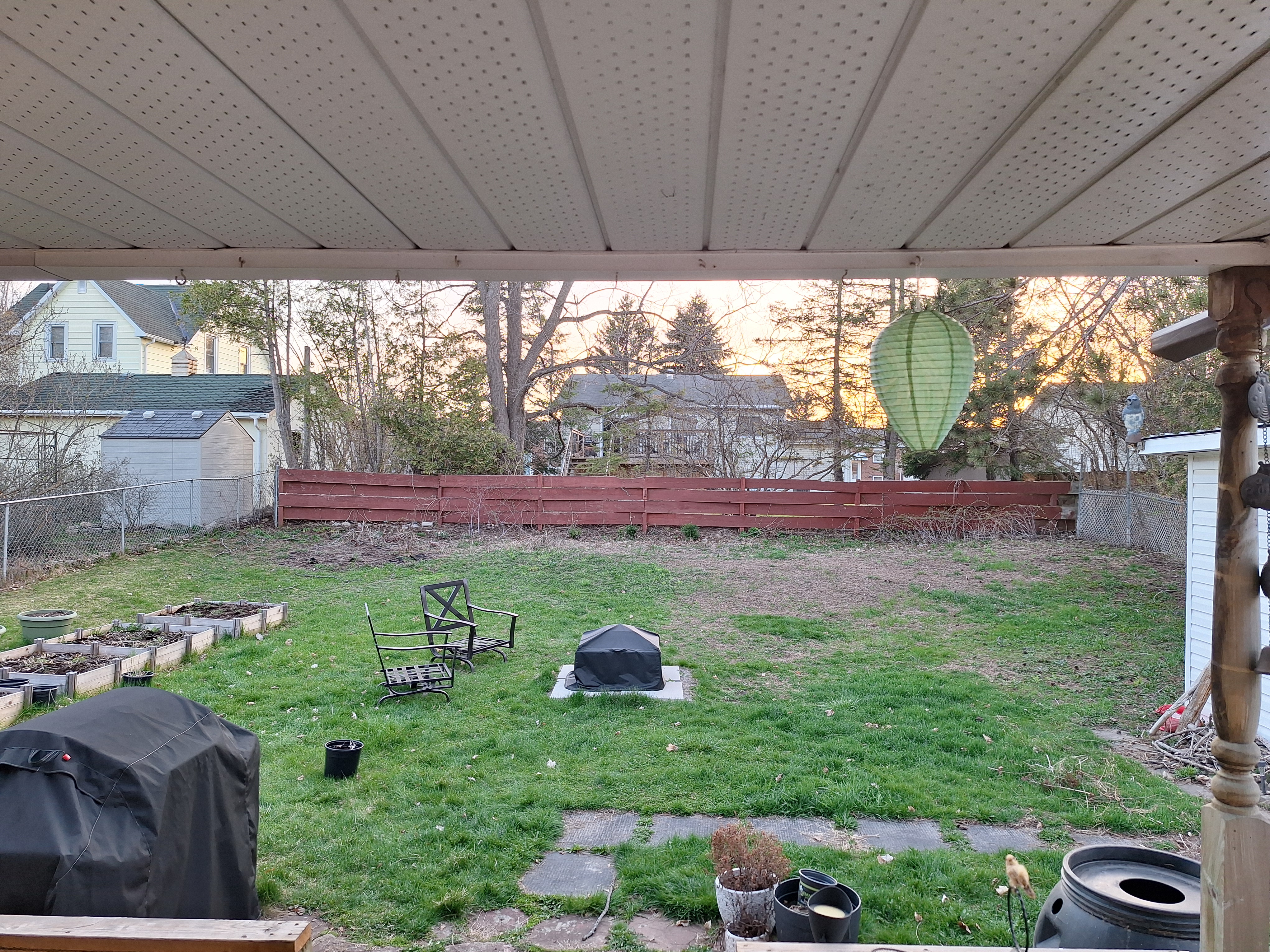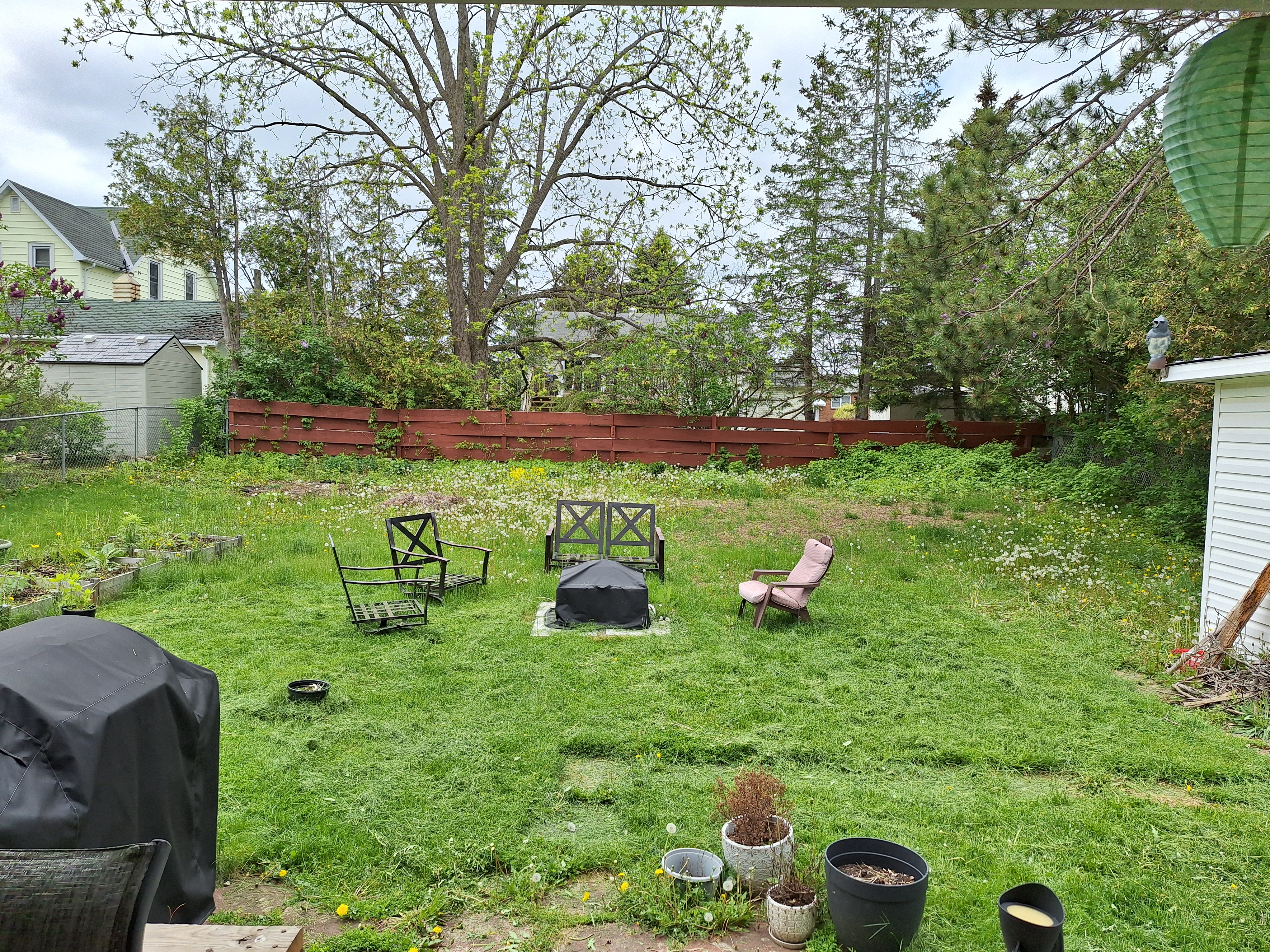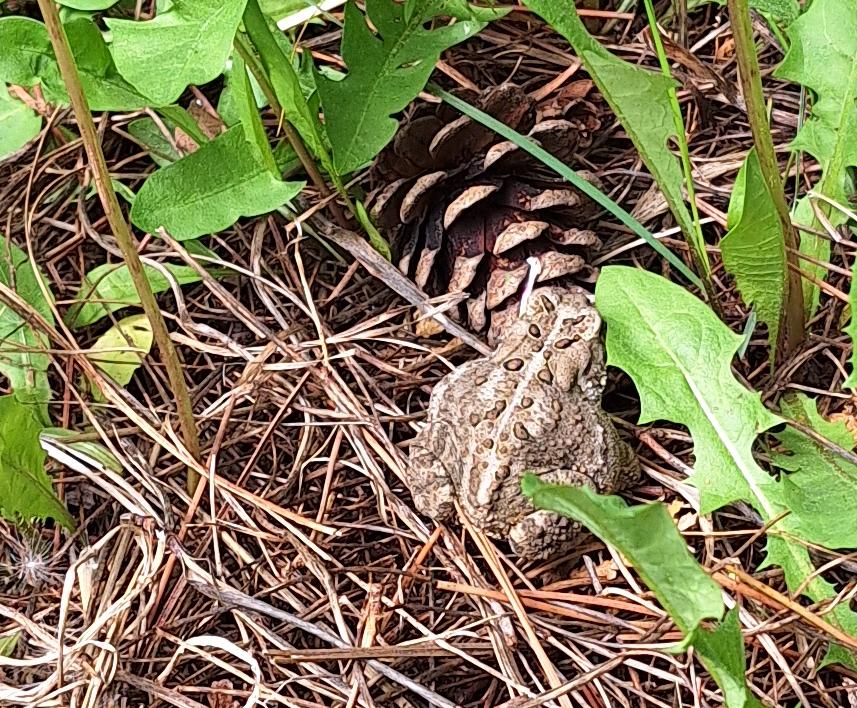Thoughts on Backyard Ecology
My wife and I bought a house in eastern Ontario during the spring of 2023, wanting to reduce the distance from friends and family while also gaining some independence, particularly with being outdoors (our apartment wasn't great for that; I'm sure our dog and cat concur). Since then we've been slowly determining what our backyard actually is to us, and what we might do with it. This, combined with a fair amount of reading about both traditional Indigenous knowledge and modern gardening practices (where "reading" sometimes also means "watching YouTube") has led me to start viewing our backyard as an ecological system, and asking myself how it relates to the others, along with the wider region.
View From the Deck
Here's how it looked on the evening of April 28th, 2025.

And here's how it looked a little over two weeks later (after partially cutting the very long grass):

I've been considering what it might mean to do a study on this kind of environment, in a way that's both useful to our future plans as stewards of the space, and interesting to others who might've had the same idea. This project would involve collecting quantitative data whenever possible, composing it along with any other observations we can make. To make it meaningful as an ecological (and maybe anthropological) study, it'd need to:
- Be accessible and repeatable by others without highly-technical expertise;
- Span multiple years and scopes;
- Recognize our place within it, rather than impartial observers.
I'm not formally trained in any sort of biology, ecology, or environmental science program that would provide a foundation for this project. However, the process should be doable with access to a library, the Internet, and/or others with similar experience. We need a good template - probably a guide or two, with associated spreadsheets for filling out all sorts of details about the backyard ecology. Keeping it at this level means the digital tools will remain available from a web browser and shouldn't require more than a GMail account. I'll have to start developing a spreadsheet template soon, using observations from my own backyard as a springboard.
Practical Considerations
- Given that we live in the shadow of changing climates and drastically-reduced habitat for wildlife, tracking observations across multiple years seems critical for understanding our impact and changes in the local area.
- These can include anything from precipitation and temperature extremes to the presence of specific species of bird, rodent, even the odd sighting of larger fauna. I remember hearing on local discussion groups about the presence of coyotes in town - I don't think they ever came near our house, but it's worth noting, if for no other reason than as part of a broader look at the region's environmental properties.
- It's also definitely worth tracking classifications that existing organizations put out for the areas these backyards are located in. I'm thinking things like Köppen climate classifications and Plant Hardiness Zones.
- The best way to track flora and fauna (other than visual identification) might be by cross-referencing weight/size/dietary/etc. characteristics from Wikipedia, along with other traits as able
- A camera capable of taking photos as much as every hour would be handy for timelapse, and possibly motion-sensing
Equipment/Software Needs
Some/all of the following would be useful:
- An IP camera that can be accessed via script - automatic, periodic snapshot collection. Something with motion sense would be even better
- A variety of instruments like soil samplers, rain gauges, temperature sensors, and other IoT sensors (if we want to get really detailed)
- Public data on biomes, waterways, precipitation, wildlife ranges, etc.
As far as #1 goes, there are a lot of fairly cheap outdoor, solar-powered IP security cameras available that might work. I couldn't find much for soil samplers (the closest I got was this site, but they seem more large-scale farming oriented), but rain gauges and temperature measurement are easy in theory. The public data might be a bit tricker to collect and could be outdated (see the habitat maps in this video as an example).
The language of choice for developing any analysis tools is probably Python - I'm comfortable with it and it's easy for others to learn. In addition to generating interesting plots, I'm also wondering about a massive table contrasting the different physical and temporal characteristics of things we find.
Similar Projects
I did some searching for the phrase backyard ecology in Google. The top results seem to be mainly for helping backyard gardeners out, but there are no deeply technical posts in the first few pages (maybe there's a reason for that and my approach will have issues). Plenty of incredibly useful posts and videos, though. I did find this page from Portland State University. The website matching the search phrase is about providing a community and resources for building vibrant backyard ecosystems.
Someone else made a nice blog covering their experiences and tips on popular gardening topics. There's also Andrew Millison who has an active YouTube channel and teaches some courses at Oregon State University. I don't doubt that there are other resources similar to my idea somewhere, but I'll get started and look along the way. Notably, searching for backyard environmental study seems to get more content in psychology and news articles about academic programs.
Impetus, or a Source of Guilt
The second picture above was taken following a near two-week journey to France. There was a lot of rainfall during and after the trip, to the point where much of the lawn had grown so tall that it looked more like a forest meadow, and my unpowered mower wouldn't cut it. While clearing it with the snipper, I disturbed this creature (Wikipedia):

I felt bad about it, and it got me thinking of our goals. I'd like to create a thriving little space for us and small critters, one that avoids having another over-mowed lawn that's desolate and uninteresting; but it's also important not to allow harmful and/or invasive species (we have a little creeping thistle and a lot of wild raspberry, among others) to overrun it. In particular, I'm interested in seeing a lot more butterflies around, which will require milkweed for monarchs and a variety of other additions. Having detailed knowledge of the space also seems crucial in our role as what are basically small-scale terraformers, and key to a sense of belonging. My hope is that maybe I'll get skilled and methodical enough at this project that it'll help others do the same, and decades from now we'll leverage all of this data to help achieve a communal understanding of the world that helps some of those solarpunk quasi-utopias of science fiction.
Conclusion
That's a scattered assortment of ideas and issues, and there's probably some stuff I've accidentally omitted. Over the next while I'm going to start posting about more specific adventures - things like camera setup and configuration, snapshots of flora and fauna with details, and more. It might also make sense for me to curate little lists of things I find useful and/or related to the project even if they aren't used. We'll see.